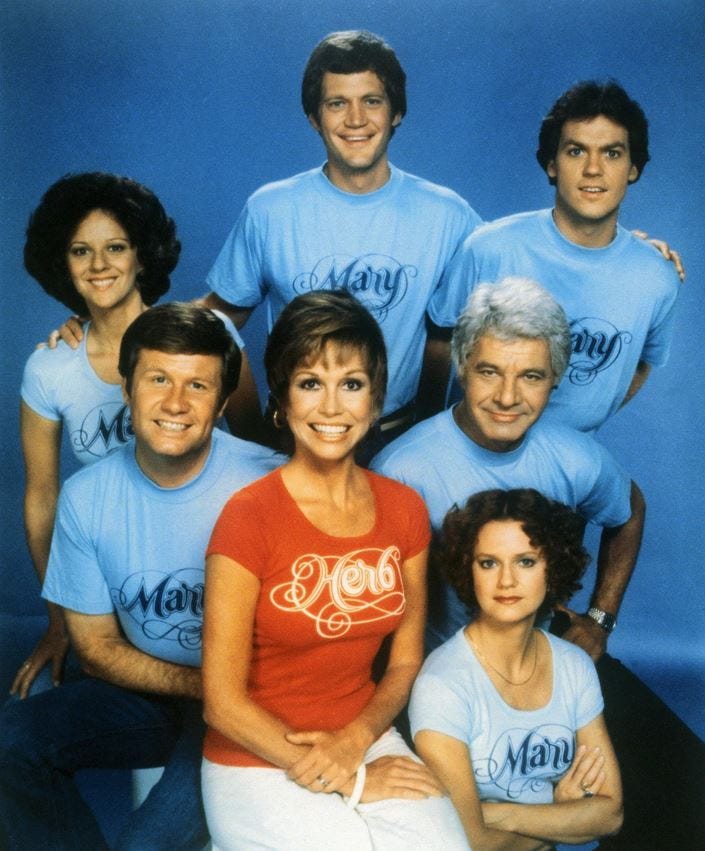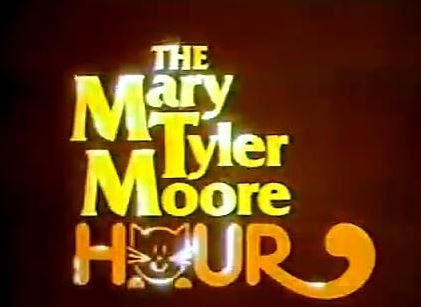C&C 7: Mary Tyler Moore and the Right Kind of Failure
What can we learn from a flop variety show?
The HBO documentary Being Mary Tyler Moore (2023) is a solid, respectful tribute that treats its subject like the icon she is. Its most interesting aesthetic choice is to dispense with the usual talking heads; thanks to the longevity of Moore’s career, director James Adolphus is able to keep his star constantly onscreen while we hear from friends, colleagues, and the many women influenced by her, among them Julia Louis-Dreyfus and Lena Waithe (who also produced the documentary). Adolphus regularly returns to an excruciating interview Moore did with David Susskind; she deserved yet another Emmy for not slapping the patronizing host in the kisser.
What I wanted out of the film—and knew I wouldn’t get—was a deep dive into one of the most fascinating bombs in television history: the short-lived variety series Mary (September-October 1978), which morphed into the slightly-longer-lived semi-variety series The Mary Tyler Moore Hour (March-June 1979).
Hey, I’m a student of setbacks. Blame all my years of rooting for the New York Mets.
Only one year after The Mary Tyler Moore show left the air, Moore returned to CBS with Mary. Doing a straight-ahead variety show was a risk; Carol Burnett had voluntarily ended her series in 1978, and the format was viewed as on the wane, at least in the traditional sense. Saturday Night Live had pushed it in a new direction.
Side note: a reminder that during the 1973-74 season, CBS’s Saturday schedule was All in the Family, M*A*S*H, The Mary Tyler Moore Show, The Bob Newhart Show, The Carol Burnett Show. Easily the single greatest lineup ever.
Moore—who tellingly refers to herself as a “failed dancer” in one of the documentary’s archival interviews—was cognizant of the challenges. Having anchored two of TV’s best-cast series in The Dick Van Dyke Show and The Mary Tyler Moore Show, she was savvy enough to surround herself with another accomplished ensemble. Along with known commodities like James Hampton and Dick Shawn, Mary featured a bounty of young talent: Michael Keaton, Swoosie Kurtz, and David Letterman. (Smart casting is an MTM hallmark. Her subsequent attempts to return to the small screen—none of which are mentioned in the documentary—tend to feature at least one noteworthy name. Her 1985 sitcom, also called Mary, costarred a pre-Peg Bundy Katey Sagal. Playing her stepson in 1988’s Annie McGuire: future Academy Award winner Adrien Brody.)
Of the thirteen episodes of Mary filmed in 1978, only three aired. Let this incomplete edit of one show explain why.
Or I can save you the time. Moore opens with Loudon Wainwright III’s “Dead Skunk.” A later sketch called “Carmen Meringue News” is exactly what it sounds like—some white guys in some tutti-frutti hats—and it goes on forever, like an SNL bit that airs at 12:45 AM. For a controlled dose of what Mary briefly had to offer, “enjoy” this number: Moore and company performing “With a Little Luck” by Wings, with Letterman clearly wishing he were elsewhere.
How to describe it? I’ll let Swoosie Kurtz handle it. In her memoir Part Swan, Part Goose, she wrote:
And yes, that is one of the most important women ever to grace the television industry, tortuously chipper, executing choreography that looks like ... bossa-nova-meets-yeast-infection.
I’m on the record as a huge Keaton fan. I never missed him on Letterman, because they had the highwire chemistry of people who had been through the wars together. On Keaton’s final appearance on The Late Show, this clip was dredged up. Letterman said, “Every Wednesday the choreographer would come in and teach us—Michael and myself and the rest of the cast—how to dance and the big number … It was the worst day of my life for an entire summer.” Keaton added, “It was unbelievably uncomfortable, was it not?” In the same interview, Letterman admitted he was so scarred by his Mary stint that it led him to turn down multiple invitations to host SNL.
Here’s an unaired episode, with a Saturday Night Fever parody and an always-timely film noir send-up. It never really got better.
Mary was retooled, returning several months later as The Mary Tyler Moore Hour. In the mold of The Jack Benny Program while prefiguring The Larry Sanders Show, it followed the behind-the-scenes antics as “Mary McKinnon” prepped her weekly variety series, with special guests like Bonnie Franklin and Hal Linden. The original Mary cast was dropped, save for Keaton as studio page Kenny, a forerunner of 30 Rock’s Kenneth (Jack McBrayer); Letterman recurred in a few episodes.
Arnie Kogen, who wrote for The Mary Tyler Moore Hour, said that the series aimed to introduce an “edgier Mary” and that viewers “did not like this ‘new’ Mary.” Here’s a playlist of episodes if you’d care to make up your own mind.
I understand why none of this is in Being Mary Tyler Moore. The documentary sticks to Moore’s triumphs in other fields: winning a special Tony Award in 1980 for the role originally played by Tom Conti in Whose Life Is It Anyway? and her Oscar-nominated, against-type turn in Ordinary People (1980).
That’s because the Mary/The Mary Tyler Moore Hour debacle is perceived not only as a failure, but the wrong kind of failure. One seen as a dead end. But every show business narrative needs the right kind of failure, an early misstep that opens doors and creates second acts.
Moore endured such a calamity, and Being Mary Tyler Moore covers it in detail. Coming off The Dick Van Dyke Show, Moore secured a film deal with Universal that allowed her to select her projects. Things got off to a good start with Thoroughly Modern Millie (1967). But then Moore was offered the lead in a stage musical adaptation of Truman Capote’s Breakfast at Tiffany’s, a show that was initially named after her character, Holly Golightly. Moore was so determined to star in the production—stacked with behind-the-scenes heavyweights like Abe Burrows (Guys and Dolls), Bob Merrill (Funny Girl), and Edward Albee, with Richard Chamberlain as her costar—that she traded away control over her films for the opportunity.
What happened? Producer David Merrick took out an ad in the New York Times announcing that Breakfast at Tiffany’s would close in previews “rather than subject the drama critics and the public to an excruciatingly boring evening.” Moore was thrust into middling comedies with desperate, late-‘60s titles like What’s So Bad About Feeling Good? (1968) and Don’t Just Stand There! (1968). (The documentary shows that Moore kept leatherbound copies of all her scripts including these two, punctuation marks and all.) The nadir came when she played a nun opposite doctor Elvis Presley in Change of Habit (1969). Adrift, she appeared in a TV special called Dick Van Dyke and the Other Woman designed to showcase her versatility. Its ratings triumph led directly to The Mary Tyler Moore Show.
The appeal of such stories is obvious, but every failure offers lessons. Mary may not have burnished the MTM legacy, but it launched several major careers. Moore later wrote that Keaton “was the first young actor I’d worked with to make me aware of a new pace and rhythm potential in sketch comedy.” She took justifiable pride in her role in Letterman’s ascent, observing “I watch his show now with a feeling of propriety.” (The documentary includes several Ordinary People-era excerpts from Moore’s appearance on Letterman’s own right kind of failure, his Emmy Award-winning morning show that lasted a mere four months but paved the way for his late-night run.) Kurtz called Mary “a bold experiment … an act of sheer balls, on (Moore’s) part, and I was lucky to be a part of it,” noting, “What I took away from the experience was a determination to never again miss out on the joy of the company I was in, and that has come in handy on many occasions.”
Knowing I was never going to get the exhaustive, multi-part history of Mary I craved, I settled for the closest equivalent. The Hulu documentary Too Funny to Fail (2017) chronicles the development and seven-week lifespan of The Dana Carvey Show (1996). The ABC sketch comedy featured maybe the greatest collection of talent in modern television: Robert Smigel, Louis CK, Charlie Kaufman, Bob Odenkirk, 30 Rock’s Robert Carlock, and a pair of unknown Chicago improv performers, Stephen Colbert and Steve Carell.
The show never recovered from its ill-advised opening sketch, featuring Carvey as a lactating Bill Clinton; it wasn’t exactly what Home Improvement viewers were looking for next. The documentary includes comments from a TV critic who changed his mind about the series as it found its footing, as well as enthusiastic fan Bill Hader. I’m not sold on the show personally—decide for yourself—although Germans Who Say Nice Things remains funny.
The Dana Carvey Show comes off simultaneously as both the right and wrong kind of failure. Colbert and Carell would springboard directly to The Daily Show, largely due to a single sketch. Kaufman became a phenom, writing Being John Malkovich, Adaptation, and Eternal Sunshine of the Spotless Mind. But Carvey himself, white hot after leaving SNL at the height of his fame, would never get a chance like this again. That he speaks about the show with candor and affection is to his credit.
Still, I wish someone would get Keaton, Kurtz, and Letterman on the record about Mary. Where else am I going to get my fix of talent, money, and expectations aligning, only to end in despair and disappointment?




This was awesome, VK. I too wondered why those ill-fated shows after the original MTM series were largely ignored. I went to IMDB to get more info, but you've thankfully filled in the gaps. -MK